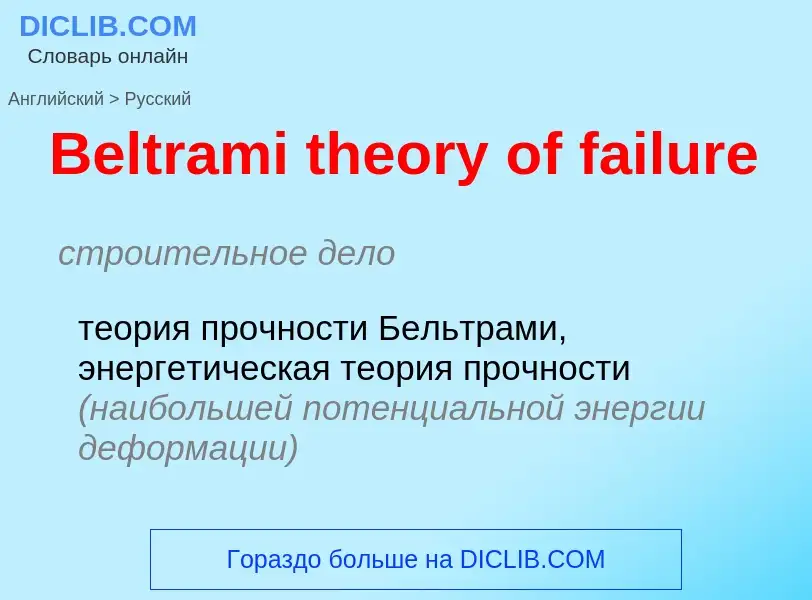Перевод и анализ слов искусственным интеллектом
На этой странице Вы можете получить подробный анализ слова или словосочетания, произведенный с помощью лучшей на сегодняшний день технологии искусственного интеллекта:
- как употребляется слово
- частота употребления
- используется оно чаще в устной или письменной речи
- варианты перевода слова
- примеры употребления (несколько фраз с переводом)
- этимология
Beltrami theory of failure - перевод на русский
строительное дело
теория прочности Бельтрами, энергетическая теория прочности (наибольшей потенциальной энергии деформации)
медицина
сердечная недостаточность
Определение
.
Википедия
Mohr–Coulomb theory is a mathematical model (see yield surface) describing the response of brittle materials such as concrete, or rubble piles, to shear stress as well as normal stress. Most of the classical engineering materials follow this rule in at least a portion of their shear failure envelope. Generally the theory applies to materials for which the compressive strength far exceeds the tensile strength.
In geotechnical engineering it is used to define shear strength of soils and rocks at different effective stresses.
In structural engineering it is used to determine failure load as well as the angle of fracture of a displacement fracture in concrete and similar materials. Coulomb's friction hypothesis is used to determine the combination of shear and normal stress that will cause a fracture of the material. Mohr's circle is used to determine which principal stresses will produce this combination of shear and normal stress, and the angle of the plane in which this will occur. According to the principle of normality the stress introduced at failure will be perpendicular to the line describing the fracture condition.
It can be shown that a material failing according to Coulomb's friction hypothesis will show the displacement introduced at failure forming an angle to the line of fracture equal to the angle of friction. This makes the strength of the material determinable by comparing the external mechanical work introduced by the displacement and the external load with the internal mechanical work introduced by the strain and stress at the line of failure. By conservation of energy the sum of these must be zero and this will make it possible to calculate the failure load of the construction.
A common improvement of this model is to combine Coulomb's friction hypothesis with Rankine's principal stress hypothesis to describe a separation fracture. An alternative view derives the Mohr-Coulomb criterion as extension failure.

![horizontal fissure]]. Yet, no obvious lung edema is seen. Overall, this indicates intermediate severity (stage II) heart failure. horizontal fissure]]. Yet, no obvious lung edema is seen. Overall, this indicates intermediate severity (stage II) heart failure.](https://commons.wikimedia.org/wiki/Special:FilePath/Chest radiograph with signs of congestive heart failure - annotated.jpg?width=200)


![Siderophages (one indicated by white arrow) and pulmonary congestion, indicating left [[congestive heart failure]] Siderophages (one indicated by white arrow) and pulmonary congestion, indicating left [[congestive heart failure]]](https://commons.wikimedia.org/wiki/Special:FilePath/Histopathology of pulmonary congestion and siderophages.jpg?width=200)
![[[Kerley B lines]] in [[radiograph]] of acute cardiac decompensation. The short, horizontal lines can be found everywhere in the [[right lung]]. [[Kerley B lines]] in [[radiograph]] of acute cardiac decompensation. The short, horizontal lines can be found everywhere in the [[right lung]].](https://commons.wikimedia.org/wiki/Special:FilePath/Kerley-B-Linien.jpg?width=200)
![Model of a normal heart (left); and a weakened heart, with over-stretched muscle and dilation of [[left ventricle]] (right); both during [[diastole]] Model of a normal heart (left); and a weakened heart, with over-stretched muscle and dilation of [[left ventricle]] (right); both during [[diastole]]](https://commons.wikimedia.org/wiki/Special:FilePath/Right side heart failure.jpg?width=200)



